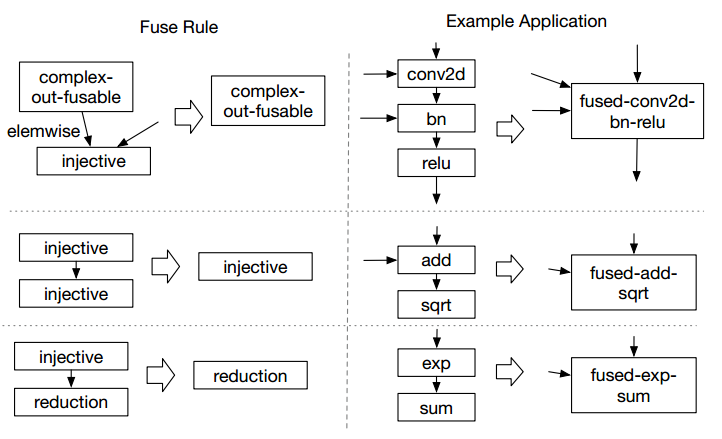TVM图优化(以Op Fusion为例)
首先给出一个TVM 相关的介绍,这个是Tianqi Chen演讲在OSDI18上用的PPT https://files.cnblogs.com/files/jourluohua/Tianqi-Chen-TVM-Stack-Overview.rar
对于图优化来说,位于整个软件编译栈比较高的层次:

首先给出计算图的定义
Computational graphs: a common way to represent programs in deep learning frameworks
对于图优化来说,有很多种图优化手段:Operator Fusion
Constant Parameter Path Pre-Computation
Static Memory Reuse Analysis
Data Layout Transformation
AlterOpLayout
SimplifyInference
这里仅以Operator Fusion做例子介绍
Operator fusion : combine multiple operators together into a single kernel without saving the intermediate results back into global memory
也就说是说算子融合省掉了中间数据的store过程
在TVM中,有三种融合规则:

其中,算子属于哪一类是算子本身的特性(这个地方不是特别懂,这个属性有非常多的值),但是能融合的规则只有这三种。
但是这种store是如何减少的,在IR上有明确的体现。
下边的例子,我会使用tvm.relay来进行介绍,relay是TVM中实现的一种高级IR,可以简单理解为另一种计算图表示。其在TVM所处的位置如下图所示

比如,我们假设我们要完成一个y = exp(x+1.0)的计算图
给出测试代码(来自于源码中的test_pass_fuse_ops.py,有改动):
import tvm from tvm import relay def test_fuse_simple(): """Simple testcase.""" def before(): x = relay.var("x", shape=(10, 20)) y = relay.add(x, relay.const(1, "float32")) z = relay.exp(y) return relay.Function([x], z) def expected(): x = relay.var("p", shape=(10, 20)) y = relay.add(x, relay.const(1, "float32")) z = relay.exp(y) f1 = relay.Function([x], z) x = relay.var("x", shape=(10, 20)) y = relay.Call(f1, [x]) return relay.Function([x], y) z = before() z = relay.ir_pass.infer_type(z) # print(z.astext()) zz = relay.ir_pass.fuse_ops(z, opt_level=2) print(zz.astext()) zz = relay.ir_pass.infer_type(zz) zz = relay.ir_pass.fuse_ops(zz) zz = relay.ir_pass.infer_type(zz) after = relay.ir_pass.infer_type(expected()) # print(after.astext()) assert relay.ir_pass.alpha_equal(zz, after)
在融合前,其IR(方便用户看的一种形式,不是真正的IR)
fn (%x: Tensor[(10, 20), float32])
-> Tensor[(10, 20), float32] {
%0 = fn(%p0: Tensor[(10, 20), float32],
%p1: float32)
-> Tensor[(10, 20), float32] {
%1 = add(%p0, %p1)
%1
}
%2 = %0(%x, 1f)
%3 = fn(%p01: Tensor[(10, 20), float32])
-> Tensor[(10, 20), float32] {
%4 = exp(%p01)
%4
}
%5 = %3(%2)
%5
}
融合后:
fn (%x: Tensor[(10, 20), float32])
-> Tensor[(10, 20), float32] {
%0 = fn(%p0: Tensor[(10, 20), float32])
-> Tensor[(10, 20), float32] {
%1 = add(%p0, 1f)
%2 = exp(%1)
%2
}
%3 = %0(%x)
%3
}
可以很明显的发现,省掉了一次数据store过程




